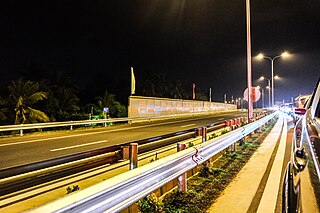
Transport in Sri Lanka is based on its road network, which is centred on the country's commercial capital Colombo. A rail network handles a portion of Sri Lanka's transport needs. There are navigable waterways, harbours and three international airports: in Katunayake, 35 kilometres (22 mi) north of Colombo, in Hambantota, and in Jaffna.

The Sri Lanka Railway Department is Sri Lanka's railway owner and primary operator. As part of the Sri Lankan government, it is overseen by the Ministry of Transport. Founded in 1858 as the Ceylon Government Railway, it operates the nation's railways and links Colombo with other population centres and tourist destinations.

The 2011 Alawwa rail accident, occurred on the evening of Saturday 17 September 2011, when a passenger train, Sri Lanka Railways S11, drove into an observation car at the back of a stationary Intercity Express train near the Alawwa railway station, approximately 60 km (37 mi) northeast of Colombo. The accident resulted in the death of five people, including a French national, a Thai Buddhist monk and the train driver, with over 30 injured. The Intercity Express had been pushing a Rambukkana-bound train from Colombo, which had stalled near Alawwa. The accident may have been caused by human error, and the S11 train ran into the observation car at the end of the other train.
Polgahawela is a town located in north western Sri Lanka. It is most notable for being a major railway junction.

Yal Devi is a major express train in Sri Lanka. Operated by Sri Lanka Railways, the Yal Devi connects Colombo, the nation's commercial hub, with the northern cities of Jaffna and Kankesanturai. From 1990 up to 2015, the service had to terminate at intermediate stations, due to the Sri Lankan civil war. The Northern Line was rebuilt and returned to Jaffna Railway Station by October 2014 and Kankesanturai by January 2015.
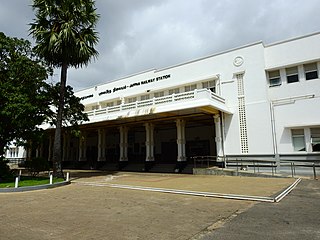
Jaffna railway station is a railway station in the city of Jaffna in northern Sri Lanka. Owned by Sri Lanka Railways, the state-owned railway operator, the station is one of the busiest in the country, linking the north with the capital Colombo.

The northern line is a railway line in Sri Lanka. Branching off the Main Line at Polgahawela Junction the line heads north through North Western, North Central and Northern provinces before terminating at the northern port of Kankesanthurai. The line is 339 kilometres (211 mi) long and has 55 stations between Polgahawela Junction and Vavuniya. It is the longest railway line in Sri Lanka. The line opened in 1894. Major cities served by the line include Kurunegala, Anuradhapura, Vavuniya,Kilinochchi and Jaffna. The popular Yal Devi service operates on the line. The line was severely affected by the civil war and no services operated north of Vavuniya after 1990. Reconstruction of this section of the line commenced following the end of the civil war in 2009 and was fully completed in early 2015.
The Mannar line is a railway line in Sri Lanka. Branching off the northern line at Medawachchiya Junction, the line heads north-west through North Central and Northern provinces before terminating at the town of Talaimannar. The line is 106 kilometres (66 mi) long and has 11 stations. The line opened in 1914.

The Main Line is a major railway line in the rail network of Sri Lanka and considered by many to be one of the most scenic train journeys in all of Asia. The line begins at Colombo Fort and winds through the Sri Lankan hill country to reach Badulla.

The coastal line is a major railway line in Sri Lanka, running between Colombo Fort and Beliatta, via Galle and Matara. Operated by Sri Lanka Railways, the line includes some of the busiest rail services in the country. The line has been extended to Beliatta on 8 April 2019 and is proposed to be extended to Kataragama, via Hambantota. With a designed maximum speed of 100 km/h (62 mph) between Kalutara and Matara, and a maximum speed of 120 km/h (75 mph) between Matara and Beliatta, the line is one of the fastest in Sri Lanka.

Kandy railway station is a major railway station in Kandy, Sri Lanka. The station is served by Sri Lanka Railways and is the primary railway station in Kandy and one of the most significant in the central hills. The station sits on a branch of the Main Line, leading to the Matale Line.
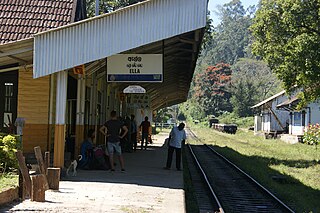
Ella is a small town in the Badulla District of Uva Province, Sri Lanka governed by an Urban Council. It is approximately 200 kilometres (120 mi) east of Colombo and is situated at an elevation of 1,041 metres (3,415 ft) above sea level. The area has a rich bio-diversity, dense with numerous varieties of flora and fauna. Ella is surrounded by hills covered with cloud forests and tea plantations. The town has a cooler climate than surrounding lowlands, due to its elevation. The Ella Gap allows views across the southern plains of Sri Lanka.

Pattipola railway station is the 66th station on the Main Line, and is 226.8 km (140.9 mi) away from Colombo. It is the highest railway station in Sri Lanka with an elevation of 1,897.5 m (6,225 ft) high above mean sea level. The station has one platform with a second track as a siding loop. All the trains that run on the Main Line, including the Podi Menike and Udarata Menike express trains stop at the station.
Rajarata Rejini is a daytime passenger train that runs between Anuradhapura and Beliatta via Colombo Fort in Sri Lanka.
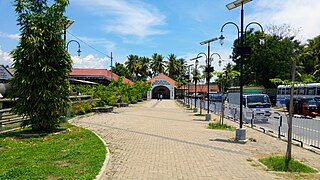
Rambukkana Railway Station is a railway station in the Kegalle District, Sabaragamuwa Province, Sri Lanka. The station is served by Sri Lanka Railways, which is the state-run railway operator.
Colombo - Badulla Night Mail Train is a night time passenger and mail train that runs between Colombo and Badulla in Sri Lanka.

Polgahawela Junction railway station is a major junction station, situated in the Kurunegala District, North Western Province, Sri Lanka. It is the 34th railway station on the Main line and is 73.83 kilometres (45.88 mi) away from the Colombo Fort Railway Station, at an elevation of 74.39 metres (244.1 ft) above sea level. The station is located at the centre of Polgahawela and is a main junction point joining two railway lines; one coming from the upcountry of Sri Lanka and another from the northern part of the country.

Kurunegala Railway Station is a major station, situated in the Kurunegala District, North Western Province, Sri Lanka. It is the 5th railway station on the Northern Line and 39th overall from the Colombo Fort Railway Station, at an elevation of 122.86 metres (403.1 ft) above sea level. The station is located 2.2 km (1.4 mi) away from Kurunegala's town centre.
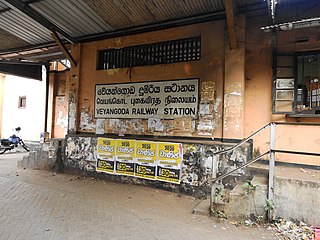
Veyangoda railway station is a railway station in the Western Province, Sri Lanka. The station is served by Sri Lanka Railways, which is the state-run railway operator.















